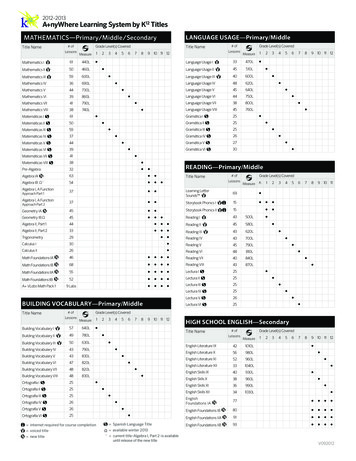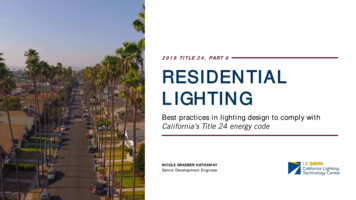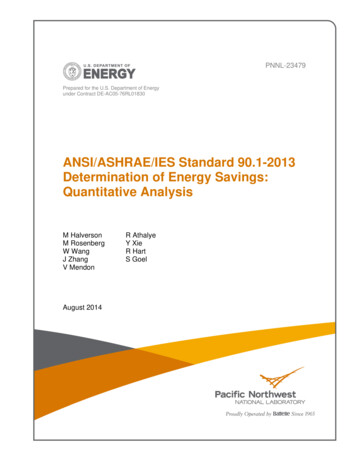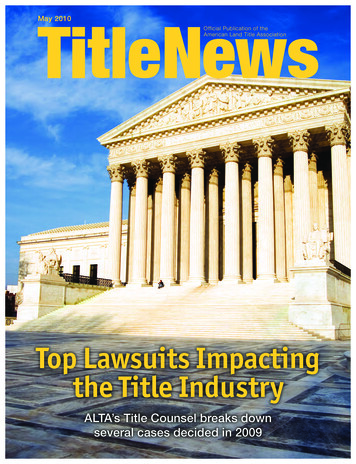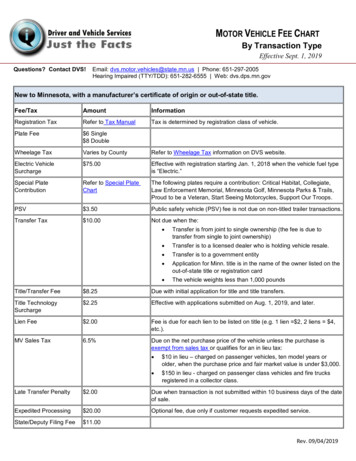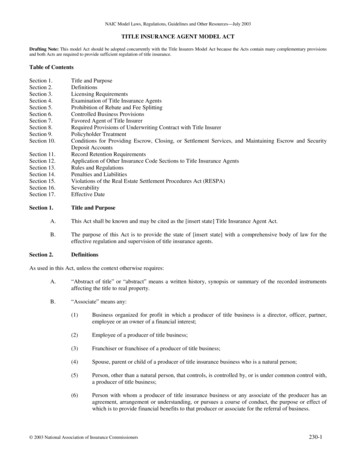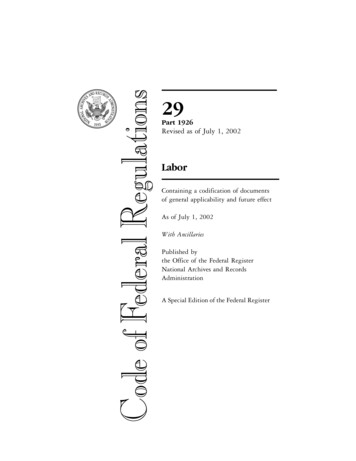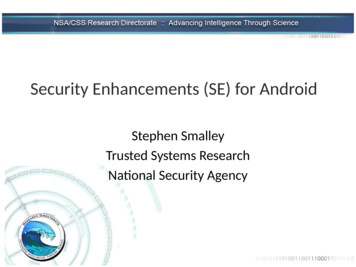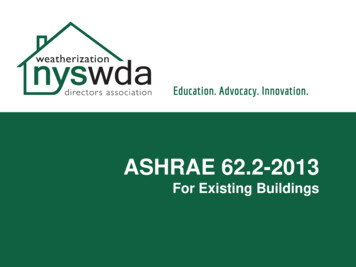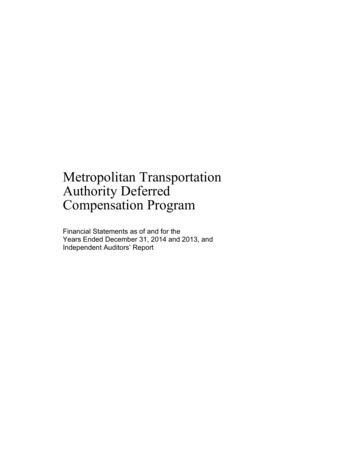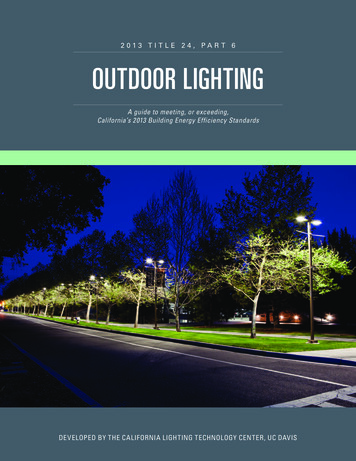
Transcription
2013 TITLE 24, PART 6OUTDOOR LIGHTINGA guide to meeting, or exceeding,California’s 2013 Building Energy Efficiency StandardsDEVELOPED BY THE CALIFORNIA LIGHTING TECHNOLOGY CENTER, UC DAVIS
2014, Regents of the University of California,Davis campus, California Lighting Technology CenterGuide Prepared by:California Lighting Technology Center (CLTC)University of California, Davis633 Pena DriveDavis, CA 95618cltc.ucdavis.eduProject Partners:California Energy CommissionPacific Gas and Electric CompanyThis guide is designed to help builders and lighting industry professionals become more familiar with thenonresidential outdoor lighting measures in California’s Building Energy Efficiency Standards (Title 24, Part 6).The guide provides information on current lighting technologies, lighting design terms and principles, andbest-practice recommendations. It is designed to complement lighting courses developed through CLTCand sponsored by Pacific Gas and Electric Company through its participation in the Statewide Codes andStandards program.
2 013 T IT L E 24, PA R T 6:OU T DOOR L IGH T INGCONTENTS1 INTRODUCTION2 CONCEPTS & PRINCIPLESBest Practices. 11Efficacy & Perceived Brightness. 12Life & Lumen Maintenance. 13Color Characteristics. 14Lighting Zones. 16BUG Rating System. 173 TECHNOLOGY OVERVIEWCommon Source Types. 23Control Strategies. 25Emerging Technologies. 27Finding CompliantLighting System Devices. 284 REQUIREMENTS &RECOMMENDATIONSNew in 2013: An Overview of Updates. 31Additions, Alterations & Repairs. 33Mandatory Requirements. 34Prescriptive Requirements. 38Outdoor Sign Lighting. 425 APPENDIXGlossary. 45Tables. 51Resources. 54
42013 TITLE 24, PART 6
CHAPTER 1INTRODUCTIONTHE BENEFITS OFEFFICIENT OUTDOOR LIGHTINGEnergy and Cost SavingsExterior lighting has shown a slow yet steady increase in California over thepast several years. Outdoor lighting now accounts for approximately onefifth of California's lighting electricity consumption.1 Inefficient light sourceswaste energy, as do luminaires that operate for long hours at full power,even when outdoor areas are vacant. California's 2013 Building EnergyEfficiency Standards (Title 24, Part 6) outdoor lighting requirements aredesigned to substantially reduce this energy waste.Lighting power allowances and other requirements are based on the mostrecent Illuminating Engineering Society (IES) recommendations, industrybest practices, and the market availability of cost-effective, energy-efficientlamps, luminaires and controls.Reduced Light PollutionThe 2013 iteration of Title 24, Part 6 replaces the cutoff classificationsystem with the current IES-standard rating system for assessing backlight,uplight and glare (BUG). 2 The new standards do not address backlight, butthey specify uplight and glare rating requirements for luminaires basedon their installed lighting zone. This will help minimize light pollution andreduce hazardous glare, creating a safer, healthier environment at night.Improved SafetyPHOTO: CREE, INC.Lighting plays a critical role in helping people navigate outdoor spaces safelyat night. Implementing motion-sensing lighting controls, photosensors andscheduling controls are strategies included in the standards for improvingefficiency and minimizing light pollution without compromising safety and security.1California Lighting Technology Center, Energy Efficiency & Renewable Energy Lighting ElectricityUse in California: Baseline Assessment to Support AB 1109 (Task 2.18). May 2014.2TM-15-11: Luminaire Classification System for Outdoor Luminaires defines a classification systemfor outdoor luminaires that provides information to lighting professionals regarding the lumendistribution in zones of specific interest.OUTDOOR LIGHTING GUIDE5
INTRODUCTIONABOUT THIS GUIDEThis guide is designed to supplement Section 6 of the California Energy Commission’sNonresidential Compliance Manual, which covers the requirements for outdoor lighting.The guide is designed to help lighting industry professionals, contractors and others becomemore familiar with the latest Title 24, Part 6 nonresidential standards as they apply to outdoorlighting of hardscape areas.The introductory section includes guidance for identifying and specifying compliant lightingproducts as well as an overview of the compliance process, from design to final inspection.Concepts & PrinciplesThis section of the guide covers lighting concepts such as lumen output, efficacy,color temperature, and color rendering.Technology OverviewThis portion of the guide describes the most common luminaire types for outdoor spaces,as well as available source technologies, sensors and control devices.Requirements & RecommendationsThe most critical code requirements for outdoor lighting and controls are explained in thissection, along with recommendations for deploying effective and efficient outdoor lightingsystems. Recommendations for meeting or exceeding the standards are provided, withcase studies and examples of calculations that must be performed to verify compliance.NOTE: This guide is not intended to be used in lieu of California’s Title 24 Building Energy Efficiency Standards,and it is not a substitute for the code itself. Please visit www.energy.ca.gov / title24 to download theofficial 2013 Title 24 Building Energy Efficiency Standards, Errata, Reference Appendices, and theResidential Compliance Manual.62013 TITLE 24, PART 6
PHOTO: CLTC, UC DAVISOUTDOOR LIGHTING APPLICATIONSThe Title 24, Part 6 requirements for outdoor lighting apply to hardscape areas. This typicallyconsists of the paved portions of an outdoor building site but may also include planters or othersmall areas of landscaping within the application area. Sections 110.9, 130.0, 130.2, 130.4,140.7, and 150.0 apply to newly constructed outdoor lighting systems. Section 141.0 applies tooutdoor lighting systems that are either additions or alterations.The following outdoor lighting applications are regulated under Title 24, Part 6:ApplicationCode SectionHardscape areas:Parking lots, private roadways,driveways, sidewalks,walkways, bikeways,and plazas§ 130.2 Outdoor lighting controls and equipment§ 140.7 Requirements for outdoor lighting§ 130.3(a)2 Outdoor sign lighting controlsSignage§ 140.8(a)Maximum allowed lighting powerOR§ 140.8(b)Alternate lighting sourcesThe following items are not regulated under Title 24, Part 6: Outdoor lighting that serves facilitiesin occupancy group "I" such ashospitals and correctional facilities Temporary outdoor lighting Landscape lighting Lighting for athletic fields andplaygrounds Lighting for outdoor live performances Outdoor lighting in qualifiedhistoric buildings Industrial site lighting Lighting of public monuments Lighting on public streets, roadways,highways, and traffic signs Lighting required and regulated bythe Federal Aviation Administration(FAA) or US Coast GuardOUTDOOR LIGHTING GUIDE7
INTRODUCTIONTHE COMPLIANCE PROCESSLighting industry professionals must understand and apply the standards during the designphase in order to create energy-efficient, code-compliant and cost-effective lighting systems.This guide focuses on the first three steps in the compliance process. Primary responsibility forcompliance enforcement rests with the authority having jurisdiction (AHJ). An AHJ is typicallyassociated with a city or county government.Step 1: Comply with All Mandatory MeasuresSections 110.9, 130.0, 130.2, 130.3, 130.4, 141.0All outdoor spaces must be designed to comply with the mandatory measures ofTitle 24, Part 6.Step 2: Comply with All Prescriptive RequirementsSections 140.7 and 140.8In addition to meeting the mandatory requirements, hardscape areas must meet lightingpower allowances specified within the standards. Lighting may not exceed the maximumlighting power allowance for the area where the lighting is installed. There are no allowancetrade-offs available between outdoor and indoor lighting.Step 3: Prepare and Submit PlansThe design team must make sure that plans include all required documents that buildingofficials will need to verify compliance. The California Energy Commission’s NonresidentialCompliance Manual provides worksheets to ensure all necessary information is included.See the appendix of this guide for a list of required forms.Step 4: Plans ExaminationA building department plans examiner must check that the proposed lighting satisfiesTitle 24, Part 6 requirements and that the plans contain the information to be verifiedduring field inspection. Once plans are approved, a building permit is issued.Step 5: Complete ConstructionThe installation team must follow the approved plans and specifications, and the buildingdepartment field inspector(s) must verify that the outdoor lighting is installed according tothe approved plans.82013 TITLE 24, PART 6
INTRODUCTIONStep 6: Commission SystemsOnce installation is complete, lighting control systems must be properly commissioned.The site operators must also be advised of their responsibilities to maintain compliancewith Title 24, Part 6 standards. They must be provided information or training on how tomaintain and operate the area's lighting and its energy features.Step 7: Pass Inspection by an Acceptance Test TechnicianTitle 24, Part 6 requires that Acceptance Test Technicians (CLCATTs) review and test outdoorlighting controls installations to ensure controls operate as required by the standards.CLCATTs trained and certified through an approved curriculum provider will: Review installation certificates and associated documentation Test installations to ensure controls are positioned and calibrated to operate incompliance with the standards Check that all necessary set points or schedules are in place as required by the standards Fill out required Certificates of Acceptance and submit these to theenforcement agencyVisit energy.ca.gov / title24 / attcp for information on ATT certification providers.Step 8: Provide Documentation to System OwnersUpon occupancy, the property owner or manager must be provided with copies of theenergy compliance documents, along with instructions for operation and maintenance oflighting systems.CALCTP-AT Technician Trainingcalctp.orgCALCTP is one of two training and certification programs recognized andapproved by the California Energy Commission to carry out lightingcontrols acceptance testing as required by Title 24, Part 6.In order to be certified as a CALCTP Acceptance Test Technician,a person must: Be employed by a listed CALCTP-certified employer:calctp.org / tacceptance-technicians / contractors Have at least three years of experience with lighting controls Register on the CALCTP website:calctp.org / acceptance-technicians Take the training course offered at one of the CALCTPtraining centers: calctp.org / training-center-listOUTDOOR LIGHTING GUIDE9
A Cure for the Common Pole: 66% Energy SavingsNorthBay VacaValley Hospital, Vacaville, CAIn 2014, a state-of-the-art outdoor lighting system was installed at NorthBay VacaValley Hospital.Dimmable LED luminaires were installed in the site’s parking lots, walkways, and emergencyvehicle routes, replacing 40 induction luminaires, 13 high-pressure sodium luminaires and sevenmetal halide luminaires. The switch to LED reduced lighting energy use at the site by about 34%.Controls then cut the LED lighting's energy use 49%, reducing the site's lighting energy useby a total of 66% compared to pre-retrofit levels.A photocell, time-clock, and motion sensor (PIR or long-range microwave) control each luminaire.Luminaires are also connected to a wireless mesh network lighting control system that allowsthe facility manager to adjust lighting schedules, luminaire groupings and light levels, gatherrevenue-grade energy metering data, receive automated maintenance alerts, and more.A case study of the project is available exterior-lighting-health-care-sector.102013 TITLE 24, PART 6
CHAPTER 2CONCEPTS & PRINCIPLESBEST PRACTICESA layered and balanced approach to outdoor lighting is generally the mostenergy efficient, safe and comfortable. Rather than flooding an outdoor spacewith light, it is important to select the right sources and luminaires, place themstrategically, and pair them with appropriate lighting controls.Consult the recommended practice guides published by the IlluminatingEngineering Society for each lighting application to ensure light levels meetthe requirements for amenity while maintaining the required LPD.Primary responsibility for compliance enforcement rests with the AHJ.IES Recommended PracticesThe following publications provide detailed guidance for outdoor lightingprofessionals. A complete list of IES publications is available at:ies.org / pdf / membership / lightinglibrary.pdf TM-11-00: Light Trespass:Research Results andRecommendations TM-15-11: LuminaireClassification System forOutdoor Luminaires TM-23-11:Lighting Control Protocols PB-315-09:Outdoor Lighting: Physics,Vision, and Perception HB-10-11:PHOTO: CLTC, UC DAVISThe Lighting HandbookOUTDOOR LIGHTING GUIDE11
CONCEPTS & PRINCIPLESEFFICACY & PERCEIVED BRIGHTNESSA number of new, energy-efficient, outdoor lighting solutions are available that can producethe same amount of light (lumens) as legacy sources while consuming less power (watts).Luminous OutputThe amount of visible light emitted by a light source is measured in lumens (lm). The morelumens, the more light emitted, but other factors also affect visibility and perception ofbrightness, such as contrast ratios and color characteristics. In addition, the type of fixtureor housing can greatly affect the amount of lighting reaching its intended target.RecommendationsCompare the light output, not the power consumption, of existing andreplacement light sources or luminaires to ensure adequate lighting is maintained. Consider other factors, such as contrast, distribution and color quality;these also affect nighttime vision and perceived brightness. Install lighting controls, such as motion sensors, to maximize energy savingswhile automatically tailoring light levels to occupants' needs.Luminous EfficacyIn lighting, the term efficacy refers to the ratio of luminous output produced by a light source topower consumed by that source (lm / W).Efficacy Lumens / Rated WattsDifferent source technologies provide different efficacy levels. For example, a ceramic metalhalide lamp typically has an efficacy of 75 – 110 lm / W while an LED source may produce upto 130 lm / W.A Prescription for More Efficient LightingKaiser Permanente, Fresno, CAIn May 2010, Kaiser Permanente joined five leading healthcare systemsin forming the Healthier Hospitals Initiative with the goal of improvingsustainability and lowering operating costs in the healthcare sector.Fresno was the first medical center within the Kaiser Permanente systemto replace all of its existing HID parking lot lighting with LED luminaires.PHOTO: CREE, INC.Annual energy savings from the retrofit are estimated at about 57%,saving approximately 20,000 in annual energy costs and bringingthe project’s payback period to just five years. The LED luminairesalso dramatically reduced maintenance costs.122013 TITLE 24, PART 6The new lighting met the project team’s goal of improving illuminationlevels and uniformity for staff and visitors “The parking lots are welllit, and feel safe and secure,” says Kathy Boswell, staff project managerwith National Facilities Services (NFS).A case study of the project is available atcree.com / Lighting / Applications / Indoor-and-OutdoorApplications / Healthcare / Kaiser-Permanente-Medical-Fresno-CA.
CONCEPTS & PRINCIPLESLIFE & LUMEN MAINTENANCEWhen assessing the value of a new lighting system, initial product costs are only one factor toconsider. It is also important to compare lifetime lighting performance, including how well thesystem will maintain the necessary light levels.Electric light sources have the potential to fail due to several factors, including faulty electricalcomponents or corrosion inside the lamp. Light sources also lose some of their initial lumenoutput over time. This gradual decrease in light output is called lumen depreciation.High-pressure sodium lamps, like those often found in cobrahead luminaires, typically last20,000 – 40,000 hours and lose about 20%3 of their initial lumen output before burning out. Aninduction lamp lasts about 100,000 hours and loses about 30%4 of its lumen output before failing.LEDs do not fail suddenly in the same way that high-pressure sodium and many other legacysources do. Instead, their lumen output decreases gradually over time. LED cobraheadluminaires are typically rated to last 50,000 – 100,000 hours before losing 30% of their initiallumen output.Data from LED life testing programs indicates the diodes may maintain useful light outputlonger than previously predicted. Capacitors or other components that provide power to theLED circuit are more likely to fail before the LEDs reach their end of useful life.RecommendationsFollow these best practices to achieve long-lived outdoor lighting systems: Pair LED luminaires with manufacturer recommended controls Observe manufacturers’ recommendations on operating temperature toprevent heat-related performance degradation Order models with dimming drivers When possible, connect light points with networked controls to improvecontrol strategies If networked controls are not yet possible, plan for the future. Consider luminaires thatcan accept controls such as those have the NEMA 7-pin twist-lock receptacle on board.3Department of Energy, Induction Lighting: An Old Lighting Technology Made New in.4Department of Energy, LED Application Series: Outdoor Area blications/pdfs/alliances/outdoor area lighting.pdf.OUTDOOR LIGHTING GUIDE13
CONCEPTS & PRINCIPLESCOLOR CHARACTERISTICSColor Temperature (CCT)Correlated color temperature (CCT) indicates the warmth or coolness of a light’s appearance andis measured in Kelvin (K). Light sources with a low CCT emit a warmer light that is more yellow oramber in appearance while those with higher CCT values provide light with a cool white, or morebluish, appearance. Outdoor luminaires and lamps are available with CCTs ranging from about2500 K to 6000 K.Choose CCTs that are appropriate for the community. Encourage buy-in for installations bygathering input from occupants through surveys and smaller demonstration projects.2000 K2500 K3000 KWARM3500 K4000 K4500 KNEUTRALMetal Halide Retrofit in Davis, CAThe high-pressure sodium lamps to the left in this photo have alower CCT, and a lower CRI, than the metal halide lamps to the right.2013 TITLE 24, PART 65500 KCOOLWARM145000 KCOOL6000 K6500 K
CONCEPTS & PRINCIPLESColor Rendering (CRI)The color rendering index (CRI) is the current industry standard for measuring how accuratelya light source renders the colors of the objects it illuminates when compared to a referencelight source. The maximum CRI value is 100. The Illuminating Engineering Society and theU.S. Department of Energy Municipal Solid-State Street Lighting Consortium recommenda CRI of 50 or higher for roadway and street lighting. For parking and area lighting, theDesignLights Consortium recommends a minimum CRI of 65.75 CRI, 6000 K CCTPHOTO: PACIFIC GAS AND ELECTRIC; ENERGY SOLUTIONS0 CRI, 1700 – 1800 K CCTLED Retrofit in San Jose, CAThese photos were taken before and after a streetlight retrofit in San Jose, CA. The pre-retrofitlow-pressure sodium lights (left) have a low CRI while the post-retrofit LED lights (right) have a high CRI.For more information: k-controls-san-joseOUTDOOR LIGHTING GUIDE15
CONCEPTS & PRINCIPLESLIGHTING ZONESPHOTO: CREE, INC.Section 10-114Section 140.7Dark-Sky OrdinancesA growing number of localgovernments have passeddark-sky ordinances that lowerlighting power allowances ascompared to Title 24. Checkwith the local permittingauthority to determine if theproject site's default lightingzone designation has beenaltered by local jurisdiction.The standards assign lighting power allowances based on four outdoor lighting zones,LZ1 – LZ4. Lighting Zone 1 (LZ1) maintains the lowest illumination level with the lowestlighting power allowances; this is the default designation for government parks,recreation areas and wildlife preserves. LZ2 is the state default designation for ruralareas, and LZ3 is the state default designation for urban areas. There are no LightingZone 4 (LZ4) areas in California, but LZ4 allows the highest lighting power allowances.Lighting zones are based on the latest (2010) U.S. Census Bureau data. They aredesigned to help limit light pollution and ensure light levels are appropriate for thepurposes different areas serve. General hardscape power allowances have beenupdated for Lighting Zones 1, 3 and 4 in the 2013 standards.To determine the lighting zone for a project, visit the U.S. Census Bureau's FactFinderwebsite, factfinder2.census.gov, select Advanced Search, Geographies, and theAddress tab. Then enter the site address to determine if the site is in an urban area.If this is not indicated, the site is designated as rural.PHOTO: CREE, INC.The Energy Commission mustreview and approve any changesto LZ designation.Beginning with the 2005 Title 24 standards, the California Energy Commissionhas specified lighting power allowances based on project locations and whether thesurrounding environment is wild (dark), rural (characterized by low ambient light levels)or urban (characterized by higher ambient light levels).Lighting Zone 1 (LZ1)Lighting Zone 2 (LZ2)Dark: parks and preservesLow: rural areasNOT CURRENTLYAPPLICABLE IN CALIFORNIALighting Zone 3 (LZ3)Lighting Zone 4 (LZ4)Medium: urban areasHighNOTE: LZ4 is not a default designation. LZ4 designation can only be granted by the Energy Commissionwhen a local government applies for exceptionally high lighting power allowances.162013 TITLE 24, PART 6
CONCEPTS & PRINCIPLESBACKLIGHT, UPLIGHT & GLARE (BUG) RATING SYSTEMSection 130.2(b)Conscientious lighting designers have long sought to minimize adverse effects of nighttimelighting with luminaires that limit backlight (or light trespass), uplight (sky glow or lightpollution) and glare (high-angle brightness). In 2005, the Illuminating Engineering Society(IES) began implementing the TM-15-07 / BUG system in place of its older cutoff system ofluminaire classification.The BUG rating system helps lighting designers and engineers select luminaires that meet stateand local requirements for different outdoor lighting zones (LZ1 – LZ4). The BUG system alsoallows for better comparison of solid-state luminaires with traditional HID luminaires.The 2013 Title 24, Part 6 standards replace the cutoff system with the BUG rating system andinclude requirements limiting uplight and glare in certain applications. These requirements arebased on best practices for lighting different applications while minimizing light pollution andenergy waste.UPLIGHTGLARE100 100 90 90 80 80 60 GLARE60 30 BACKLIGHTUplight is defined as excesslighting directed up into thenight sky, above 90 degrees.This causes light pollution,or artificial sky glow.Glare is caused by light emittedbetween 60 and 90 degrees arounda luminaire. Light emitted at theseangles can be uncomfortable andeven hazardous.Backlight includes all illuminationbehind a luminaire. Backlight causeslight trespass, which occurs whenlight spills into unwanted areas.OUTDOOR LIGHTING GUIDE17
CONCEPTS & PRINCIPLESA BUG rating consists of three parts, which indicate how well the luminaire controlsbacklight, uplight and glare. Lower ratings indicate minimal amounts of stray light,light pollution or glare. The lowest possible rating in each category is 0 (B0, U0 or G0).Higher ratings, the highest being 5 (B5, U5 or G5), indicate poorer control. For example,a luminaire rated B2 - U0 -G1 delivers mediocre control of backlight, offers excellentcontrol of uplight, and controls glare well.BUG ratings correspond with the amount of light emitted at each secondary solidangle within the backlight, uplight or glare angles. Tables 130.2-A and 130.2-B of thestandards list the zonal lumen maximums allowed for uplight and glare within eachoutdoor lighting zone. The standards do not include backlight requirements. The BUGratings for different luminaires are included in most manufacturers’ photometric reports.Compliance RequirementsIES BUG Rating Resourcesies.orgMore on how BUG ratings arecalculated, along with tablesand examples, can be foundin IES Technical MemorandumTM - 15 - 11, “LuminaireClassification System forOutdoor Luminaires.”A list of BUG ratings and tablescan also be found .pdf.Applications with Uplight and Glare Limits: Outdoor luminaires using lampsor light sources rated greater than 150 watts must comply with uplight and glarelimitations if installed in the following areas:1. Parking lots and service stations2. Building entrances3. All canopies4. Outdoor dining areas5. All outdoor sales areasApplications without BUG Limits: Lamps and luminaires in these applicationsare not required to comply with BUG requirements:1. Signs2. Building facades, public monuments, statues, and vertical surfaces of bridges3. Lighting required for health or safety4. Temporary lighting5. Replacement pole-mounted luminaires in areas where all of thefollowing are true: Connected lighting power is not increased No new wiring is being installed No additional poles are being added Spacing between poles is greater than six times the mounting height ofthe existing luminairesState standards do not require luminaires selected for these purposes to comply withBUG limits, but best practices dictate limiting light trespass and preserving dark skieswhenever possible.182013 TITLE 24, PART 6
CONCEPTS & PRINCIPLESMaximum Zonal Lumens per Outdoor Lighting ZoneSecondary Solid AngleLZ1LZ2LZ3LZ4BACKLIGHT RATINGThe standards do not include backlight requirements.UPLIGHT RATINGUplight High (UH) 100 to 180 degrees10505001,000Uplight Low (UL) 90 to 100 degrees10505001,000GLARE RATING FOR ASYMMETRICAL LUMINAIRE TYPES (TYPE I, TYPE II, TYPE III, TYPE IV)Forward Very High (FVH) 80 to 90 degrees100225500750Backlight Very High (BVH) 80 to 90 5005,000Forward High (FH) 60 to 80 degreesBacklight High (BH) 60 to 80 degreesGLARE RATING FOR QUADRILATERAL SYMMETRICAL LUMINAIRE TYPES (TYPE V, TYPE V SQUARE)Forward Very High (FVH) 80 to 90 degrees100225500750Backlight Very High (BVH) 80 to 90 degrees100225500750Forward High (FH) 60 to 80 degrees1.8005,0007,50012,000Backlight High (BH) 60 to 80 degrees1,8005,0007,50012,000Tables 130.2-A and 130.2-B in Title 24, Part 6OUTDOOR LIGHTING GUIDE19
LED Lighting Drives Sales at Shelor Motor MileChristianburg, VAShelor Auto Mall replaced its 470 W metal halide shoebox luminaires with 280 W LED luminairesfrom American Electric Lighting (AEL). The retrofit increased illumination levels, improveduniformity, and increased CRI from 65 to 70, enhancing the appearance of the vehicles on display.The LED luminaires are currently controlled by a time clock to operate until 1 a.m. The site plansto install an occupancy sensor on each pole, along with the ROAM network control systemby Acuity Brands, which would increase scheduling flexibility and bring the lights up to fullbrightness any time an occupant is detected. Based on their daily hours of operation, the lightsare expected to continue operating, virtually maintenance-free, for more than 20 years, a dramaticimprovement over the MH luminaires, which required maintenance every two to three years.A case study of the project is available ies/shelor-motor-mile.202013 TITLE 24, PART 6
CHAPTER 3TECHNOLOGYOVERVIEWCHOOSING THE RIGHT LIGHTAn effective outdoor lighting system combines the right source technology withthe right luminaire and the right lighting controls for the specific application itis designed to serve. The activities supported by each outdoor space, alongwith factors such as temperature and occupancy patterns, will determine whichproducts offer the best solutions for a given project.Selecting the right type of light source and the right lighting controlsfor a given application means comparing a variety of factors, including: Light output Efficacy Distribution Color characteristics Controls compatibility Product life performance andmanufacturer warranties Long-term energy and cost savingsPHOTO: ACUITY BRANDSIn many cases, a somewhat higher up-front investment in a more efficient, morefunctional lighting system yields a much higher return in the long term. Thisoverview briefly describes the benefits and limitations of technologies currentlyon the market and offers guidance for selecting products that comply with statestandards under Title 24, Part 6 and the Appliance Efficiency Regulations underTitle 20.OUTDOOR LIGHTING GUIDE21 p
OUTDOOR LIGHTING APPLICATIONS The Title 24, Part 6 requirements for outdoor lighting apply to hardscape areas. This typically consists of the paved portions of an outdoor building site but may also include planters or other small areas of landscaping within t

